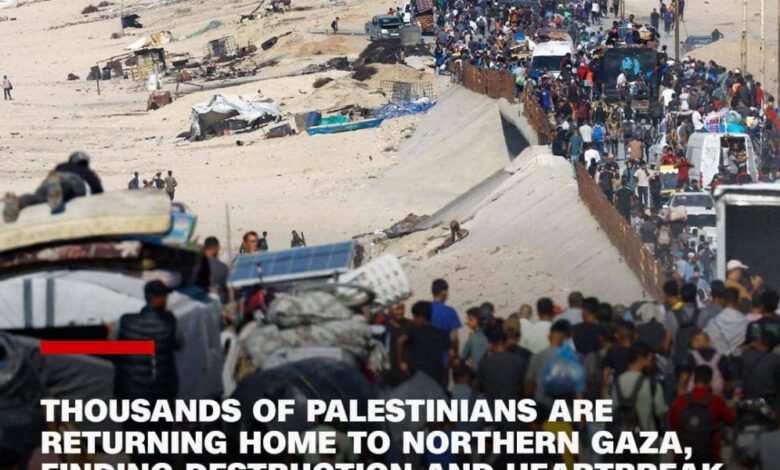Thousands Return to Gaza City as Ceasefire Takes Effect

(DDM) – Thousands of displaced Palestinians have begun a mass return from southern Gaza to Gaza City following the long-awaited ceasefire that took effect in the early hours of Friday.
Diaspora Digital Media (DDM) correspondent gathered that after months of relentless bombardment, starvation, and displacement, families are now making the difficult trek northward on foot, through rubble-strewn roads, destroyed bridges, and military checkpoints, to reclaim what remains of their homes.
For many, the journey is one of both relief and despair. Carrying sacks of clothes, blankets, and small bundles of food, they walked for miles under the burning sun, guided by memories of neighborhoods that no longer exist.
Children clutched the hands of weary parents, while elderly men and women leaned on makeshift walking sticks, determined to see the places they once called home.
Residents described mixed emotions upon arrival, tears of joy for surviving the war, and tears of heartbreak as they found entire communities turned to dust.
One returnee, 45-year-old Mariam Abu Samir, told DDM that her home in the Shuja’iyya district was flattened. “When I got here, I couldn’t even tell where my house used to stand,” she said.
“All I saw was stones, twisted metal, and ashes. But this is still my home. We have to start again somehow.”
Witnesses said the once-vibrant Gaza City, known for its bustling markets and colorful seaside, now lies in ruins. Streets that once echoed with the sounds of children playing are now filled with silence and the smell of decay.
Entire apartment blocks have collapsed, and burnt-out vehicles line the main roads.
Electricity and running water remain scarce. Many residents now depend on rainwater collection, while aid groups warn that disease outbreaks could spread due to contaminated wells and the accumulation of corpses still trapped beneath rubble.
Humanitarian convoys from Egypt and the United Nations have begun moving north, delivering food, medicine, and temporary shelters.
Still, relief workers told DDM that the level of destruction is “beyond imagination.”
The ceasefire, mediated by Egypt, Qatar, and the United States, reportedly includes terms for the exchange of prisoners, the gradual reopening of border crossings, and expanded humanitarian corridors.
However, skepticism remains high. Many Gazans recall previous ceasefires that quickly collapsed amid renewed violence.
Dr. Rami Al-Khaled, a political analyst based in Ramallah, told DDM that the truce offers “a narrow but critical window for rebuilding lives and trust.” He added, “The people of Gaza have endured one of the longest humanitarian catastrophes in modern history.
The question now is whether this ceasefire will finally translate into lasting peace.”
According to health officials, more than 36,000 Palestinians have been killed since the conflict began, with thousands more missing. Hospitals remain overwhelmed, operating from tents and damaged facilities.
The health ministry has appealed for international assistance to restore basic medical services.
As night fell over Gaza City, flickers of candlelight glowed from makeshift shelters amid the ruins.
In the distance, a few families gathered to pray, their voices rising above the eerie silence.
Despite the devastation, hope remains a stubborn flame among the survivors. “We will rebuild with our hands,” said 29-year-old Mohammed Darwish, holding his infant son. “We have lost everything, but we still have each other, and that is enough to begin again.”
For Gaza’s weary residents, the ceasefire is not merely an end to fighting, it is the beginning of another long, uncertain struggle for dignity, healing, and peace.
Post Views: 86




